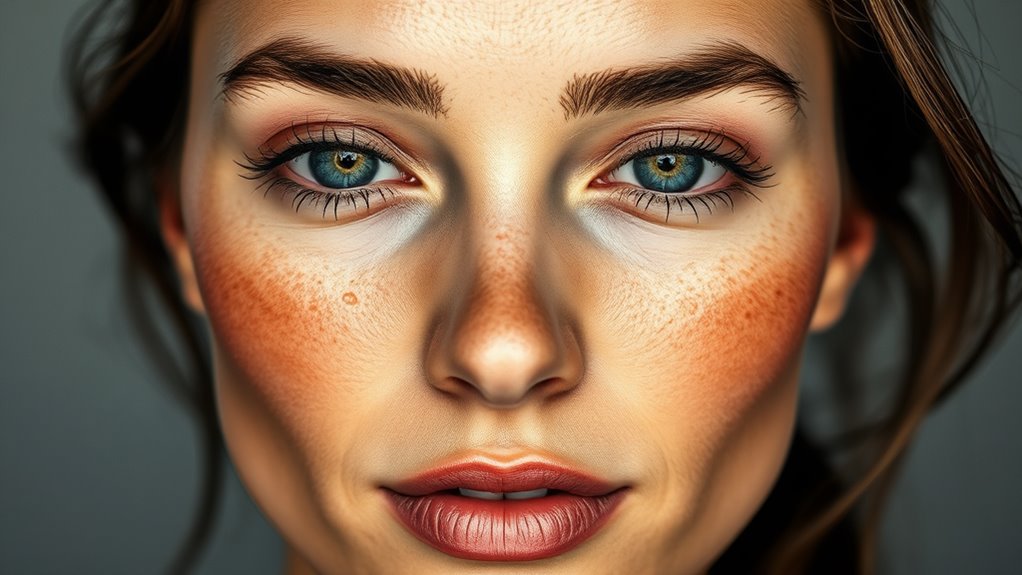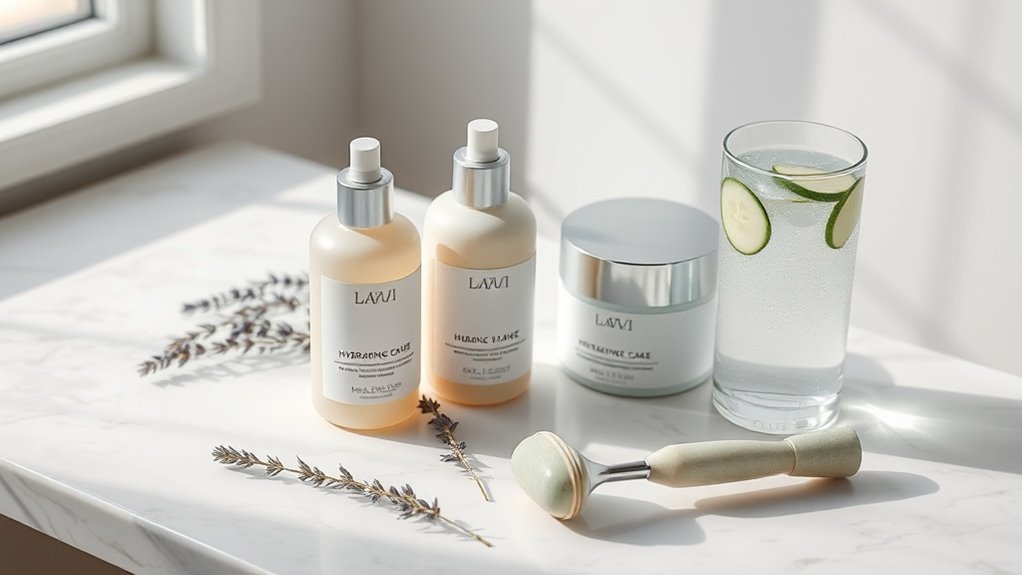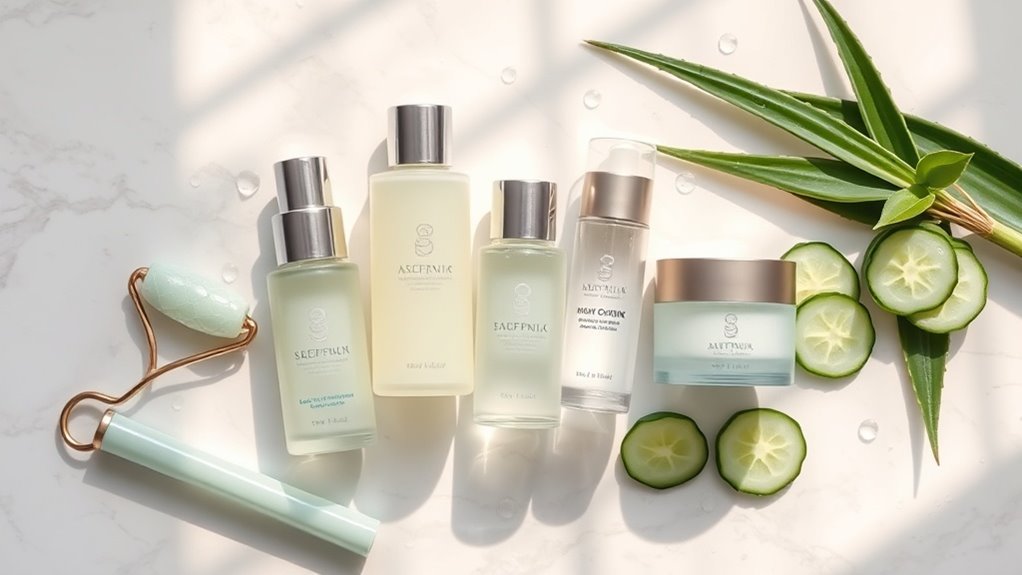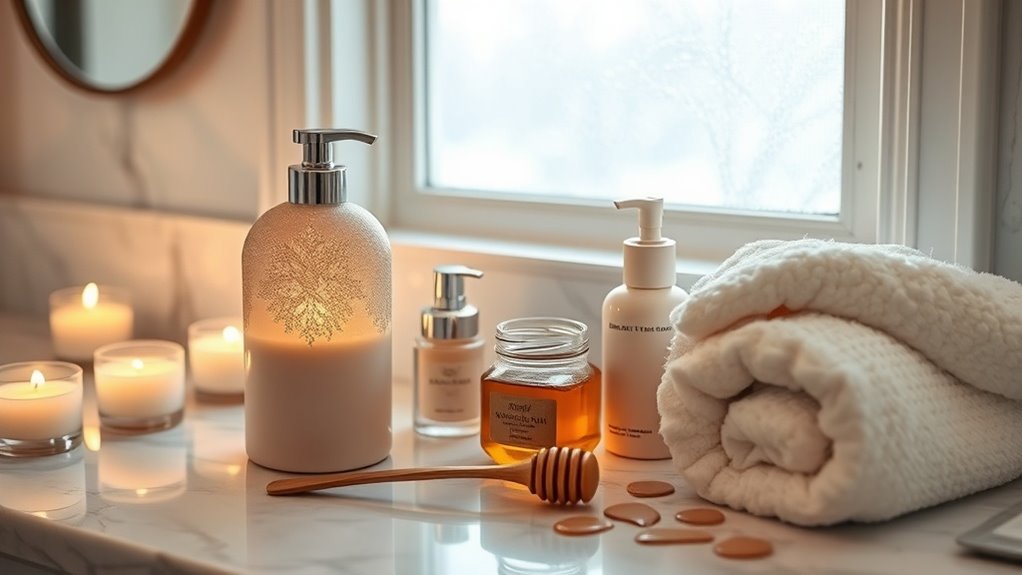Dry Patches and Oily T-Zone. Here’s What Your Skin Needs
If you’ve noticed dry patches alongside an oily T-zone, you’re not alone. This combination skin type requires a strategic approach to skincare. Understanding the causes behind these contrasting areas is essential for tailoring your routine effectively. Ignoring your skin’s unique needs can lead to irritation and imbalances. Learn how to address these specific concerns and discover the key products and habits that can transform your skin health.
Understanding Combination Skin
Combination skin presents a unique challenge for many individuals, as it often exhibits characteristics of both oily and dry skin types.
To manage your combination skin effectively, start by identifying the specific areas of your face that tend to be oily or dry. For the oily zones, use lightweight, oil-free moisturizers to prevent excess shine while keeping your skin hydrated. On dryer areas, opt for richer creams that offer deeper moisture.
Regular exfoliation is vital; it helps maintain a balanced skin texture across all areas. Incorporating gentle cleansers avoids stripping natural oils, reducing potential irritation. Additionally, understanding the causes of combination skin can further enhance your treatment approach.
Additionally, consider using targeted treatments, such as clay masks for oily spots and hydrating masks for dry patches. These combination skin tips will help you achieve a more balanced complexion.
Causes of Dry Patches and Oily T-Zone
Your skin type can vary significantly, often leading to dry patches and an oily T-zone.
Environmental stressors, like pollution and weather changes, can exacerbate these conditions, while hormonal influences also play a key role in skin behavior. Understanding these factors is crucial for developing an effective skincare routine tailored to your unique needs. Incorporating affordable remedies into your skincare regimen can significantly improve your skin’s overall health.
Skin Type Variations
While many individuals strive for a flawless complexion, understanding skin type variations—particularly the causes of dry patches and an oily T-zone—can be crucial for targeted skin care.
Your skin type is often determined by genetic factors, hormone levels, and your skin’s natural moisture production.
Dry patches typically arise from insufficient oil production, leading to dehydration in certain areas.
Conversely, an oily T-zone results from overactive sebaceous glands, producing excess sebum primarily in areas like the forehead, nose, and chin.
Hormonal fluctuations, diet, and even your skincare routine can further influence these traits, resulting in combination skin.
Recognizing your unique skin type allows you to tailor your approach, ensuring effective treatments for both dryness and excess oil.
Environmental Stressors
Environmental stressors significantly impact skin health, influencing the balance between dryness and oiliness. Factors like pollution, UV radiation, and harsh weather conditions strip your skin of its natural moisture, leading to dry patches.
Simultaneously, these stressors can trigger excess oil production, particularly in your T-zone, as your skin attempts to compensate for the loss. High levels of humidity may exacerbate oiliness, while extreme cold can result in irritated, flaky patches.
Additionally, indoor heating and air conditioning alter humidity levels, further disrupting skin equilibrium. To safeguard your complexion, incorporate protective antioxidants and moisturizers in your routine that combat these adverse effects.
Recognizing and addressing these environmental influences is crucial for maintaining optimal skin health.
Hormonal Influences
Hormonal fluctuations play a pivotal role in the skin’s health and can be a primary cause of both dry patches and an oily T-zone.
Estrogen and progesterone levels fluctuate during menstrual cycles, pregnancy, or menopause, affecting your skin’s moisture balance. When estrogen levels drop, your skin can become drier and more prone to irritation. Conversely, an increase in androgens can lead to overactive sebaceous glands, creating an oily T-zone.
Stress-induced cortisol surges can further exacerbate these conditions, as cortisol disrupts your skin’s barrier function.
Understanding these hormonal influences enables you to take targeted skincare actions, such as using hydrating products during hormonal ebb and flow or adjusting your routine to manage oiliness effectively. Tailoring your skincare to these changes can significantly enhance your skin’s resilience.
Importance of a Balanced Skincare Routine
A balanced skincare routine is crucial for maintaining healthy skin, as it addresses specific skin needs, prevents common issues, and enhances your natural glow.
When you tailor your regimen appropriately, you’re not just protecting your skin but also promoting its overall health.
-
Targeted Treatments: Using specific products for dry patches and oily areas ensures that each skin concern is addressed effectively.
-
Hydration Balance: Proper hydration reduces excess oil production while nourishing dry spots.
-
pH Regulation: A balanced routine maintains your skin’s natural pH, keeping bacteria at bay.
-
Protection Against Environmental Factors: Consistent care shields your skin from pollutants and UV rays, preserving its vitality. Additionally, skincare on the go strategies can help you maintain your regimen even when you have a busy schedule.
Incorporating these elements enhances your complexion and boosts your confidence.
Recommended Products for Combination Skin
Finding the right products for combination skin is crucial for maintaining balance.
You’ll want to focus on moisturizers that hydrate without clogging pores, as well as effective cleansers that can address both dry and oily areas. In particular, products that incorporate soothing ingredients can help alleviate any sensitivity in the dry patches while treating excess oil in the T-zone.
In this next section, we’ll cover the best options that cater specifically to your skin’s unique needs.
Best Moisturizers for Combination
Choosing the right moisturizer can make all the difference in managing combination skin, as it often presents unique challenges with both oily and dry areas.
The ideal moisturizer balances hydration without exacerbating oiliness. Here are four highly recommended options:
-
Neutrogena Hydro Boost Gel-Cream – Lightweight, non-comedogenic formula with hyaluronic acid for hydration.
-
Clinique Dramatically Different Moisturizing Gel – Provides hydration while controlling excess oil; perfect for combination skin.
-
Belif The True Cream Aqua Bomb – Offers intense hydration through herbal extracts, ideal for soothing dry patches.
-
Tarte Drink of H2O Hydration Boost – This gel moisturizer replenishes moisture while being oil-free, making your skin feel fresh and balanced.
Incorporating one of these moisturizers can help achieve a more unified complexion.
Balancing Cleansers to Use
Since combination skin requires targeted care, using a balancing cleanser becomes essential for maintaining the skin’s health.
Look for formulas that effectively address both dryness and oiliness. Gel-based cleansers, for instance, can cleanse the pores without stripping natural oils. Products containing gentle exfoliants like salicylic acid help to unclog pores in the T-zone while hydrating ingredients like glycerin or hyaluronic acid nourish drier areas.
Some recommended products include the La Roche-Posay Toleriane Purifying Foaming Cream and Neutrogena Hydro Boost Cleansing Gel.
These options are effective yet gentle, balancing oil production without aggravating dry patches. Always test a small area before full application to avoid potential reactions.
Your skin deserves a cleanser that understands its unique needs.
Daily Habits to Improve Skin Health
To boost your skin health effectively, integrating daily habits into your routine is essential.
These practices not only enhance your skin’s appearance but also support its overall function.
Here are four habits to adopt:
-
Stay Hydrated: Drinking enough water helps maintain skin elasticity and radiance.
-
Balanced Diet: Incorporate antioxidants, healthy fats, and vitamins to nourish your skin from within. Foods rich in antioxidants and healthy fats can significantly improve skin health.
-
Sun Protection: Use a broad-spectrum SPF daily, even on cloudy days, to protect against UV damage.
-
Consistent Cleansing: Cleanse your skin twice daily to remove impurities without disrupting its natural barrier.
When to Seek Professional Help
When should you consider seeking professional help for your skin? If you experience persistent dryness or oiliness that doesn’t respond to over-the-counter products, it’s time to consult a dermatologist.
Likewise, if you notice sudden changes in your skin’s texture, pigmentation, or the appearance of new growths, professional assessment is crucial.
Conditions like eczema, psoriasis, or acne can require targeted treatments only a specialist can provide.
Additionally, if you’re dealing with painful, inflamed, or bleeding areas of skin, seeking timely intervention is essential to prevent complications. Persistent breakouts can be a sign of underlying issues that need specialized care.
Remember, early diagnosis often leads to better outcomes, so don’t hesitate to reach out for expert guidance on your skin concerns.
Taking care of your skin is vital for overall health and confidence.




